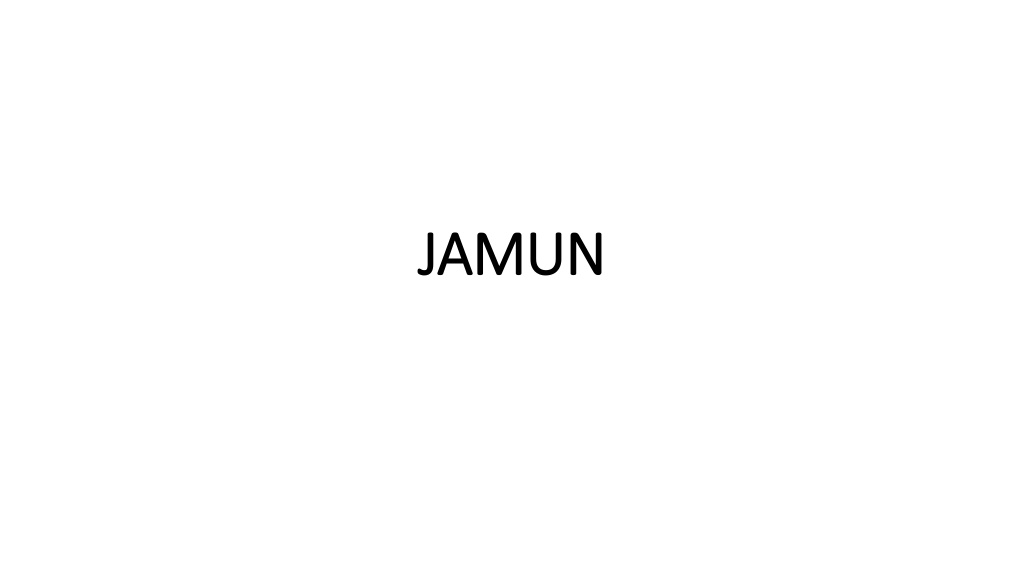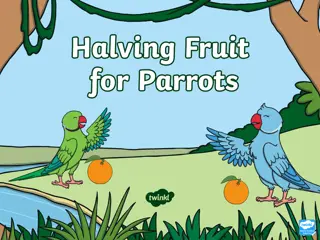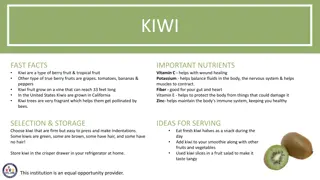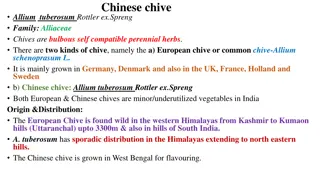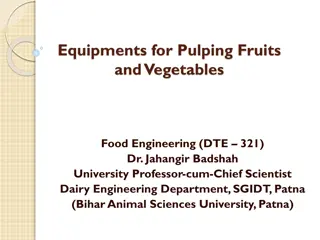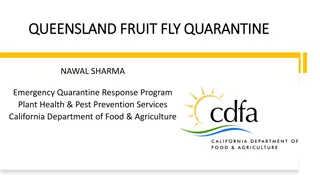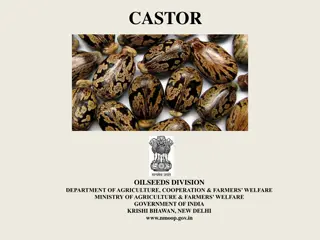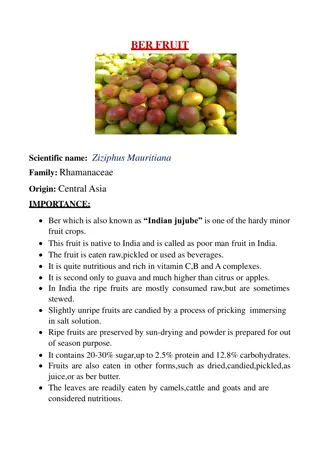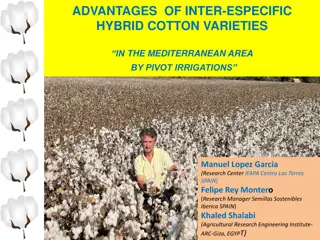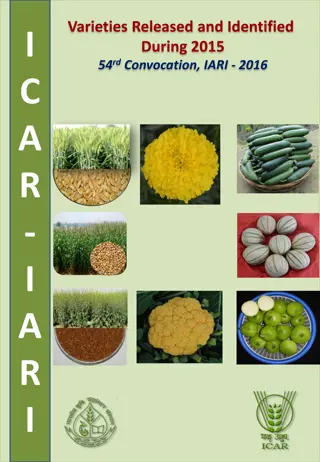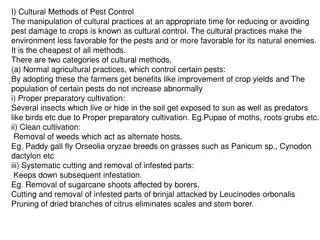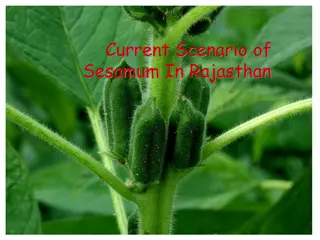Exploring the Health Benefits, Cultivation, and Varieties of Jamun Fruit
Jamun, also known as black plum, is a fruit with various health benefits such as improving haemoglobin levels, aiding in digestion, and managing diabetes. It thrives in tropical climates and a variety of soils. The fruit comes in different varieties like Ram Jamun and is propagated through both seed and vegetative methods. This article discusses the importance of Jamun, its cultivation requirements, varieties, and propagation techniques.
Download Presentation

Please find below an Image/Link to download the presentation.
The content on the website is provided AS IS for your information and personal use only. It may not be sold, licensed, or shared on other websites without obtaining consent from the author. Download presentation by click this link. If you encounter any issues during the download, it is possible that the publisher has removed the file from their server.
E N D
Presentation Transcript
JAMUN JAMUN
Scientific name : Syzygium cumini Other names: black plum, Indian black cherry, Ram jamun,Malabar plum, Java plum Origin : India (or) East indies Family: Myrtaceae
IMPORTANCE: Increases haemoglobin Keeps the heart healthy Jamun treats digestive problems Fights Respiratory problems Jamun helps with weight loss ( zinc rich activate thyroid hormones) Keeps skin healthy and radiant Diabetes management Strengthen teeths and gums Jamun protects against infections Rich in vitamin C improves immune system
SOIL -Wide range of soils For high yield potential deep loam and well drained soils -Jamun can grow well under salinity and waterlogged conditions too. However, it is not economical to grow jamun on very heavy or light sandy soils. CLIMATE: Jamun prefers to grow under tropical and subtropical climate. It is also found growing in lower ranges of the Himalayas up to an altitude of 1300 meters. The jamun requires dry weather at the time off towering and fruit setting. In subtropical areas, early rain is considered to be beneficial for ripening of fruits and proper development of its size, colour and taste.
VARITIES: Ram jamun Other varities big sized , oblong fruits Small sized , slightly round fruits deep purple or bluish-black in colour at full ripe stage deep purple or blackish in colour at full ripe stage The pulp of the ripe fruit is purple pink and the fruit is juicy and sweet. Fruit is less juicy and sweet compared to ram jamun. Fruit ripens in June and July months Fruit ripens in August
PROPAGATION: -Propagation is done by both seed and vegetative methods. -Seeds have no dormancy . Fresh seeds can be sown which germinate with in 10-15 days. -Seedlings are ready for transplanting for the use as rootstock in the following spring (February to March) or monsoon i.e. August to September. -Budding is practiced on one year old seedling stocks, having 10 to 14 mm thickness. The best time for budding is July to August in low rainfall areas. -Jamun can also be propagated by inarching but it is not adopted commercially. In this method one year old seedlings raised in pots are inarched with mother jamun trees with the help of wooden stands during June-July. -About 60% air layers are obtained , done in spring. -Semi-hardwood cuttings of both S. jambos and S.javanica, 20-25 cm long
PLANTING : Jamun is an evergreen tree and can be planted both in spring i.e. February - March and the monsoon season i.e. July-August. The latter season is considered better as the trees planted in February- March have to pass through a very hot and dry period in May and June soon after planting and generally suffer from mortalities from the unfavourable weather conditions. Prior to planting, the field is properly cleared and ploughed. Pits of 1 x 1 x 1 m size are dug at the distance of 10m both ways. Usually, work of digging of pits is completed before the onset of monsoon. The pit are filled with mixture of75% top soil and 25% well rotten farmyard manure or compost. Another common way of growing jamun trees is to plant them as shade trees near the farm dwellings and wells. Here they provide a welcome shadow besides fruit.
FERTILISER APPLICATION: The jamun trees are generally not manured. This is not because they do not require manuring or fail to respond to it but because they can stand a good deal of neglect. An annual dose of about 19 kg faI1nyard manure during the pre-beating period and 75 kg per tree bearing trees is considered. Normally, seedling jamun trees start bearing at the age of 8 to 10 years while grafted or budded trees come into bearing in 6 to 7 years. On very rich soils, the trees have a tendency to put on more vegetative growth with the result that fruiting is delayed. When the trees show such a tendency, they should not be supplied with any manure and fertilizer and irrigation should be given sparingly and withheld in September-October and again in February-March. This helps in fruit bud formation, blossoming and in fruit setting. Sometimes this may not prove effective and even more drastic treatments such as ringing and root pruning may have to be resorted to.. A fruit grower has, therefore, to be cautious in manuring and fertilizing jamun trees and hence, has to adjust the doses according to the growth and fruiting of trees.
INTERCROPPING: In the initial years of planting, when a lot of interspace is available in the orchard, appropriate intercrop especially legummous crops and vegetables can be taken dunng rainy season.
TRAINING AND PRUNING: Regular pruning in jamun is not required. However, in later years the dry twigs and crossed branches are removed. While training the plants, the framework of branches is allowed to develop above 60 to 100 cm from the ground level.
INSECTS AND PESTS: Among the pests, white fly and leaf eating caterpillar cause great damage to the tree. 1. White fly (Dialeurodes eugenia) -It damages jamun tree in all parts of India. Affected fruits get wormy appearance on the surface. -White fly can be controlled in the following ways. a. Maintain sanitary conditions around the tree. b. Pluck all affected fruits and destroy them. c. Dig up the soil around the tree trunk so that the maggots in the affected fruits and pupae hibernating in the soil are destroyed. 2. Leaf eating caterpillar (Carea subtillis) -This caterpillar is only found in Coimbatore. The insect infests the leaves and may defoliate the tree. It can be controlled by spraying Rogor 30 EC or Malathion @ 0.1 per cent. 3. Other pests -Besides the above insects, the jamun crop is seriously damaged by pests like squirrels and birds like parrots and crows. These have to be frightened away by beating the drums or flinging stones.
DISEASES: Among the diseases, the fungal disease anthracnose is notable . 1. Anthracnose (Glomerella cingulata) The fungus incites leaf spots and fruit rot. Affected leaves show small scattered spots, light brown or reddish brown in color. Affected fruits show small water soaked, circular and depressed lesions. Ultimately, the fruits rot and shrivel. Spraying with Dithane Z- 78 @ 0.2% or Bordeaux mixture at : 4:4:50 concentration shall check the disease.
FLOWERING AND FRUITING: Flowers are borne in the axils of leaves on branchlets. In North Indian conditions, flowering starts in the first week of March and continues up to the end of April. The pollen fertility is higher in the beginning of the season. The maximum receptivity of stigma is one day after anthesis. The jamun is a cross-pollinated and the pollination is done by honey bees, houseflies and wind. The maximum fruit set can be obtained by hand pollination when it is done after one day of anthesis. Thereafter, a sharp decline is observed in fruit set. There is heavy drop of flowers and fruits within 3 to 4 weeks after blooming. Later natural fruit drop can be reduced with two sprays of GA3 60 ppm, one at full bloom and another 15 days after initial setting of fruits. The pattern of growth and fruit development of jamun can be divided into three phases: the first phase from 15-52 days after fruit set having slow growth of fruit, the second phase from 52 to 58 days after fruit set having fast growth and the third and last phase from 58 to 60 days after fruit set having slow growth and very little addition in fruit weight
HARVESTING AND YIELD: The seedling jamun plants start bearing after 8 to 10 years of planting, while grafted ones bear after 6 to 7 years. However, commercial bearing starts after 8 to 10 years of planting and continues till the tree becomes 50 to 60 years old. The fruit ripens in the month of June -July. The main characteristic of ripe fruit at full size is deep purple or black color. The fruit should be picked immediately when it is ripe, because it can not be retained on the tree in ripe stage. The ripe fruits are hand picked singly by climbing the tree with bags slung on the shoulder. Care should be taken to avoid all possible damage to fruits. The average yield of fruits from a full grown seedling tree is about 80 to 100 kg and from a grafted one 60 to 70 kg per year.
STORAGE AND MARKETING: The fruits are highly perishable in nature. They cannot be stored for more than 3 to 4 days under ordinary conditions. However, pre cooled fruits packed in polythene bags can be stored well up to three weeks at low temperatures of 8 to 10 C and 85 to 90% relative humidity. The fruit is packed and sent to the market almost daily. For marketing, well ripe and healthy fruits are selected. Damaged, diseased and unripe fruits are discarded. These selected fruits are then carefully packed in wooden baskets and sent to the local markets.
COMPOSITION: Jamun fruit possesses considerable nutritive value. Apart from minerals, sugars, and proteins, it is a good source of iron also. The nutritive value of this fruit is given in the following table Sl.No Nutrient Percentage 1 2 3 4 5 6 Moisture Protein Fat Mineral Fibre Carbohydrate 28.2 0.7 0.1 0.4 0.9 19.7 7 8 9 10 Calcium Phosphorus Iron Calorific value 0.02 0.01 1.0 83/100 g
